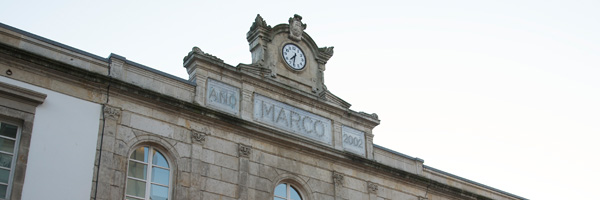


Located in the heart of the city's commercial quarter, i. e. the pedestrian and centrally situated Principe street - MARCO, Museo de Arte Contemporánea de Vigo occupies what was formerly Vigo's prison and court (1880), a place closely related to the collective memory which constitutes one of the centre's main attractions.
The very first notion of creating a museum of contemporary art in Vigo arose in 1994, with Mr. Carlos González Príncipe as city mayor. Since then and up until October 22nd 2002 -date of MARCO Foundation's constitution - a few years of work were undertaken in favour of the museum during which the refurbishment project of Vigo's old prison and court building (1880)was designed and executed.
The development of the project - a rehabilitation co-financed between Vigo City Council and the European Union (ERDF), through the Programme INTERREG II SPAIN-PORTUGAL, was commissioned to the Vigean team of architects formed by Manuel Portolés Sanjuán, Francisco Javier García-Quijada Romero and Salvador Fraga Rivas, on March 24th 1995.
Special attention has been paid to the integration of the building into its urban context by surrounding it with a pedestrian area and building a staircase linking it to the streets on the back facade and to its environment.
The refurbishment project devised by architects Manuel Portolés Sanjuán, Francisco Javier García-Quijada Romero and Salvador Fraga Rivas strictly respected the original layout of the building, which followed the "panoptical" concept developed by the British philosopher Jeremy Bentham (1748-1832). Therefore, its radial distribution has been maintained by restoring the central panoptical space within its cylindrical structure and shifting the entrance to the exhibition rooms from the main facade to the centre of the building. From this point, one can see the layout of the building: three wings and four courtyards which extend outwards from a central nucleus, all of them with rooms around their perimeter.
September 1999-December 2001
Authors of the project, architects and project managers: Salvador Fraga Rivas, Francisco Javier García-Quijada Romero and Manuel Portolés Sanjuán.
Production managers, quantity surveyors and architectural technicians: Manuel Cuquejo González, Ramiro Fraga Rivas and Julio Millara Turienzo.
Project management of special installations: IBINCO, S.L.
Safety and health coordination: Julio Millara Turienzo.
Construction company: NECSO Entrecanales Cubiertas, S.A.
MARCO's lay out is structured into four floors and an independent annexed building, occupying a total area of 10,007 sqm.
Basement area: 2,960 sqm
For technical use: storerooms, areas for the reception, care and handling of artworks in transit as well as machinery and office space for the staff. This basement is not visible from outside and is a restricted area.
Ground floor: 3,481 sqm
The front portion houses free access areas such as the cafeteria-restaurant, bookshop, cloakroom, customer service and conference room, enabling different opening and closing times to operate within the museum. The remaining 1,658 sqm are devoted to exhibition spaces and the entrance halls to them.
First floor: 2,411 sqm
The activity area covers 1,690 sqm of which two thirds is exclusively devoted to exhibitions; other spaces are the Library-Documentation Centre and the pedagogic workshop room ["Laboratorio das Artes".] The remaining area is used for transit.
Second floor: 1.012 sqm
This 880 sqm area is devoted to staff offices. In addition, it has two independent loft office spaces with exclusive access at each end of the floor which are used by the museum direction and the Friends of MARCO.
Espazo Anexo: 143 sqm
A small structure located behind the main building used as a project room. Exhibition hall: 90 sqm
Links:
[1] https://www.marcovigo.com/sites/default/files/fachada_3.jpg
[2] https://www.marcovigo.com/sites/default/files/antigua5_1.jpg
[3] https://www.marcovigo.com/sites/default/files/salas7.jpg